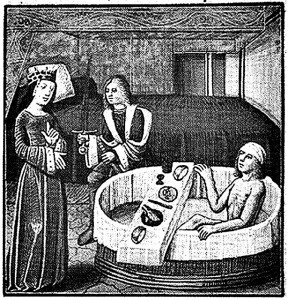“One of the misconceptions of popular history is that concern for hygiene and sanitation is a recent – and decidedly modern – phenomenon.” Simon Thurley
We don’t often think about the Tudors as being particularly hygienic people but they were actually a lot ‘cleaner’ than what we generally give them credit for. They were of course limited by the technology of the time and the challenges associated with disposing of the sewage and rubbish of a growing population but this does not mean that they did not try to keep themselves and their houses clean.
According to Alison Sim, the Tudors washed themselves a lot more often that what is generally thought. How often is not exactly known but the fact that recipes for soap and ‘hand or washing waters’ are included in household instruction manuals illustrate that there was definitely an interest in personal hygiene (Sim, Pg. 47).
Wealthy ladies used a scented toilet soap or ‘castill soap’ for their daily wash. Not all levels of society could use this type of soap, as it was imported and very expensive. The soap was made with ‘olive oil rather than the animal fat used in laundry soap’ (Sim, Pg. 47).
In Hugh Plat’s Delightes for Ladies, a 14th century household manual, he gives directions for preparing washing water suggesting the use of ‘sage, marjoram, camomile, rosemary and orange peel as possible ingredients.’ He also offers an alternative that is ‘very cheap’ once again suggesting that it was not only the wealthy Tudors that were interested in personal hygiene but people from all levels of society.
In order to have a bath most Tudors would have had to find a wooden tub, line it with sheets, collect buckets of water, heat the water by the fireplace and fill the tub. It’s probably safe to assume that this complicated process probably dissuaded people from bathing daily. There was though nothing stopping them from washing daily. The distinction being that bathing required a person to immerse themselves in a tub and washing was more like a sponge bath.
The only Tudors lucky enough to have permanent plumbing and luxurious bathrooms were royalty.
Because the water-supply determined how long the Court could stay in any one location, Henry VIII decided to overhaul the water supply systems of all of his greater houses.
Improvements made to the water supply led to improved facilities for bathing. Some of the houses Henry inherited already contained luxurious bathrooms such as Edward III’s bathroom at Westminster supplied with “2 large bronze taps for the kings bath to bring hot and cold water into the baths” (Thurley, Pg. 167).
In 1529, Henry VIII ordered a new bathroom built on the first floor of the Bayne Tower at Hampton Court. This tower was Henry VIII’s luxury suite and consisted of an office and strong-room; a bedroom, bathroom and private study and a library and jewel house (Thurley, Pg. 170).
Thurley describes the bathroom in great detail
“The Bathroom had deep window-seats with cupboards beneath and a ceiling decorated with gold battens on a white background. The baths were made by a cooper and were attached to the wall; they were supplied by two taps, one for cold water and one for hot. Directly behind the bathroom, in another small room, was a charcoal- fired stove, or boiler, fed from a cistern on the second floor which was filled by the Coombe conduit.” (Pg. 170)
Other similar bathrooms existed at the Tower of London, Windsor Castle and New Hall.
Later in Henry’s reign he started bathing in sunken baths. Thomas Platter describes Henry’s bath at Woodstock:
“We were shown King Henry VIII’s bathing-tub and bathing room, also a large square lead cistern full of water in which he bathed; the water comes from Rosamund spring, is cold in summer and warm in winter.” (Thurley, Pg. 170)
In the1540’s, Henry VIII installed a bath at Whitehall more luxurious and sophisticated than even the Hampton Court bath but we are still none the wiser as to how often Henry actually used the baths.
Thurley states that Henry, on medical advice, took ‘medicinal herbal baths’ each winter but avoided baths if the sweating sickness reared its ugly head.
A school of though existed at the time that believed that bathing was dangerous and a time that “allowed the venomous airs to enter and destroyeth the lively spirits in man and enfeebleth the body” (Thurley, Pg. 171).
Apart from bathing with scented soap, the wealthier Tudors could also afford to buy perfume. Scents were made using imported spices and so not everyone could afford such a luxury. Alison Sim believes they were used as a demonstration of one’s wealth rather than as a way of masking unpleasant odours. Sim states that if they were used to mask smells at all then it was more likely to have been the clothes rather than the people that smelt.
I imagine that wearing Tudor clothes in peak summer would have been a very sweaty affair and to try and keep the clothes smelling fresh, without the modern conveniences of deodorant, a washing machine or a dry cleaner, would have been very difficult. One way to try and remain fresh would have involved changing your undergarments as often as possible.
Whether you were wealthy or not you wore a linen undergarment called a smock or shirt (Sim, Pg. 52). The Tudors took great care in ensuring their linen was clean as it was a sign of one’s respectability. In Richard Jones’ book, Heptameron of Civil Discourses, a book about how to have a happy marriage, he says that a woman who does not wear clean linen ‘shal neither be prazed of strangers, or delight her husband’ (Sim, Pg. 52). Most would try and change their linen daily and the wealthier would have changed their linen several times per day.
In the next part of our Tudor hygiene article we will look at how the Tudors brushed their teeth, the clothes washing practices of the day and how general household cleaning was done.
References
Sim, A. The Tudor Housewife, 2010.
Thurley, S. The Royal Palaces of Tudor England: Architecture and Court Life, 1993.























VERY interesting hun! I can understand why bathing was not done daily – such a chore!
I’m still fascinated how they used rushes on the floor in many of the wealthier houses and felt as though it was alright to urinate on said rushes! *SHUDDER* at least they replaced them every few days!
Thank you Sarah! Lots more information and facts to come 🙂
I read that crosses were painted with whitewashed at a certain height on the outside walls of buildings to discourage people from urinating there. The idea was no one would dare urinate on or before a representation of The Cross and bring God’s curse on themselves.
I also saw in a woodcut a woman straddling the ditch running along the centre of the street. She had lifted her skirts and was “doing her business”. The other people paid no attention to her.
LOL! I read that during the marriage of Henry VIII and Katherine/Catherine of Aragon, that the men urinated in the hallways, wherever, and one particular pet peeve of the Queen was that the men urinated in the fireplaces either during the fire or before fires were built in them, and causing the stench to be horrible, so that she banned urinating in the fireplaces. I don’t recall if she banned urinating in the public hallways and rooms, but I do know she banned it from fireplaces. I was flabbergasted to say the least. Who would think that such men, who were supposed to be bred with courtly manners would just flip themselves out in public and urinate all over the place. That’s why I love the internet. I continue to be amazed and learn. HAHA!
(They must have been trying to show off – haha)
I also read that Queen Katherine banned the men from urinating in the fireplaces. She was such figurehead of queenship. I just love her.
Rushes actually kept the floor warm and dry and wicked away dirt and moisture. I mean it’s still gross, but rush floors deserve more credit than we think.
In the early days it was not just men at Court who urinated on floors. In alehouses and drinking halls across the land, working men and travellers would do the same and often onto a brick floor. The saving grace was that bricks were usually laid on a dirt base so the liquid would soak through the joints and soak away. Yes it was disgusting and yes it was smelly, but it was the norm so nobody thought much of it.
Great article.
Thanks Robert! More to come 🙂
Excellent article, thanks Natalie.I cant wait for part 2.
Thank you Kate! So glad you enjoyed it.
Great article….cant wait for the next installment !!!
Thank you Clare! I so enjoy learning about everyday life in Tudor England!
He also offers an alternative that is ‘very cheap’ once again suggesting that it was not only the wealthy Tudors that were interested in personal hygiene but people from all levels of society….
I would love to know what the alternative was, as it sounds like something other than herbal waters. I know the Elizabethans used to make soap balls from grated soap and herbs, but they would not be as efficient as a bar of Castile soap, which is very hard and if not machine-extruded, would last a long time (I made some, one bar of which I used in the laundry room, and tossed it after five years. I even had complaints about my soap lasting so long).
Is there anything about hair washing, and the problem of lice? I know the Victorians sometimes sewed pockets alongside their night caps for stuffing them with lavender against lice, or hops to ease insomnia…
why , on earth, would you toss it–especially after 5 years!!!! did it still wash clean ???
Fascinating article! Thanks so much. I do know Elizabeth I used her pomanders and perfumes because she really did hate a stench–don’t know so much about Henry. This is all so helpful! Can’t wait for more!
Your comment gave me a chuckle about Queen Elizabeth hating stinks/stench, when she herself probably smelled to high heaven since she bathed only once a month, “whether she needed it or not”. Maybe it was herself she was smelling and used the pomanders and stuff to keep herself from smelling herself, which I think would be hard to do anyway. I wonder where Queen Elizabeth got such bad hygiene practices from, if the Tudor people bathed a lot more than we give them credit for? Just wanted to comment and I know it is three years ago you wrote your comment and probably won’t see it, but I just found this site today. Happy New Year!
Elizabeth was a Tudor you know!
Bathing was a a chore back then as water had to be boiles and sent to the bath bucket by bucket making it hard to have a bath. Also with bathing being the full inmersión of your body into water, she probably washed herself more often, with a wet tole and sopa mentioned in the article and she probably did this daily even. Finally they also washed their undergarments frequently too!
Umm, instead of Queen Elizabeth (Tudor age),vI think you are referring to Queen Victoria, as it is her who supposedly said “I take a shower once per month whether I need it or not.” That aside, I’m sure happy that I was born in a time where we are able to wash ourselves and to NOT have to have a stench! However, even with all that we have available for ourselves to keep up good hygiene, why are there STILL people who smell to high Heaven?!
Great article…even though I’m just reading it 5 years later in 2016, lol! Love the site as well!
Actually, no, it was Queen Elizabeth I (Tudor) who said ‘I take a bath once a month whether I need it or not’. That she made that comment is quite well-known. Also, showers were not common in Victorian times. They did exist in the latter part of the Victorian age in some wealthy households, but they weren’t like modern showers – instead, they would have had a shower hose fitted to a frame over the bath, with a manual pump to deliver the water.
Yes…I stand corrected.
Queen Victoria said she had only bathed twice in her life. Once when she was born and once on her wedding night. That’s all….
What is the source for the Queen Elizabeth bathing story?
I’ve been trying to track it down and can’t find it anywhere.
Some claim it is from a letter send by the ambassador of Venice or something, but finding it seems impossible.
The quote is shared so often, one would expect there to be some record of it or at least people would consider looking for it before using it in yet another book, article, etc.
It is everywhere but I’m starting to wonder if it even exists and if it all is not just a case of people indeed confusing Elizabeth with Victoria
Hi Jo, what story are you referring to? Maybe I can help.
Queen Isabella of Spain Actually not Victoria
I would have thought that a cheaper alternative would have been to use herbs like Soaproot (Chlorogalium Pomeridianum) which as the name suggests can be pulverised to release sapoins found in the roots.
Great article. I so enjoy learning new things about the Tudor time period. Thanks for sharing.
Did they have sanitation systems, sewers, or any means of waste disposal at all?
The “toilets” of the day in a castle were built against an outside wall and the “waste” either dropped straight down and out or ran through a sort of gutter and into a hole into the moat or elsewhere. In cities the sewer has the street! Bedpans & chamber pots were dumped from the houses’ windows, giving us the term “HEADS UP!” as fair warning to passers-by. Gross, huh?
I believe Henry V111 had someone to wipe his bottom where he went to the toilet gross indeed.
Henry VIII did indeed had someone wipe his bottom for him. This was considered a valued high honor and carried the title of Master of the Stool. The biggest reason men wanted this job is that they had time every day to talk to the king, allowing you to infuence Henry or make requests. Because of the access to the king, this very personal service was reserved for men of gentle birth, even held by those of rank or nobility. Crazy, right?
The groom of the stool:) this was a very good position to be in strategically as it allowed unfettered access to the king’s ear. A privilege most others didn’t get.
When chamber pots were tossed out the window they yelled, “garde loo” basically watch out. Lol
* I might add, the castle “toilets” were little more than outhouse “holes”, not actual contraptions.. a top with a hole to sit on, and the bottom had a “way out” for the waste. The toilet as we know it (or its ancestor) was developed in the latter 1500s by courtier John Harrington as a gift to QE I.
Re: How often Henry Tudor bathed.
He certainly washed every day. By all accounts he was considered a hygiene freak by the standards of the time. The apple didn’t fall far from the tree in terms of his younger daughter.
Get reading, I have read Anne was very hygenic personally too, when is the next part coming Natalie, its very interesting….
Hi Dawn, glad you are enjoying my articles. Here is a link to part 2: https://onthetudortrail.com/Blog/resources/life-in-tudor-england/tudor-hygiene-part-2-housework/. Enjoy!
This was great. I was so happy to find out that folks changed their linens so often, I have wondered how they could stand their own stink, but now I am happy to know that they did have some care about hygiene. I had read that Henry did not like bad smells and I wondered how his many women kept from stinking. We are so lucky to have all of our lovely nice smelling products to apply after our regular showers or baths!
Why were sheets put in the tubs?
So that they didn’t get splinters from the wooden tubs
Very helpful article, extremely interesting. Helped a lot with my homework(:
very interesting article. The Tudor Housewife is a fascinating book, I learnt a lot from it.
erm that wa s a gr8 artical plz could u add facts about other rooms eg:bedroom bathroom
This is a fascinating article! I have always been curious to how clean the Tudors were and how they went about cleaning.
Hello! I love all things Merry Old England 🙂
About Tudor hygiene: Henry VIII hated stench and was repulsed by smelly women and there were many smelly women AND men in those times. While perspiration odors (armpit stinks) were commonplace and hardly avoidable, perfumes and herbs and spices were used to couneract the smell, which could be violent. As far as bathing one’s “private parts” was concerned, it was often hit or miss and, even among the higher and Royal classes, body odor, especially given the fabrics, furs and weighty robes, was pretty bad, which is why pomanders were worn, filled with aromatics, around the neck, to emit and mask stinks of various kinds. Sprigs of lavender, sage and fragrant bouquets were carried by many, to sniff and wave, to banish stinks. Sponge baths were done, but, for some reason, many avoided washing their ‘privates.’ Perhaps the …um…smell…was aphrodesiac…as it remains so even today, in some cultures (ugh!) But many who were sensitive to…smells…did wash ALL body parts, to be fresh, even applying fragrant oils to ‘those areas’ to freshen their scent. Sachets were placed in small pockets, sewn into garments and that practice was used all the way into more contemporary times. Old dresses from Southern Belles, known for daintiness, had those tiny sachet pockets sewn into the underarm, hip and seat areas. Peeing in the fireplace was done and, though disgusting to consider, it was a necessary convenience (ugh). The poor usually ‘toileted’ outside the doorway or in a ravine, common to the neighborhood. The rich or upper crust ‘toileted’ in receptacles, either looking like pottys or wide and deep enough to accomodate their…butt-ends. Dirty pottys were emptied into any waterway available or just outside the rear doors. Needless to say, houses of all classes smelled pretty foul, especially in winter and water was polluted by wastes and the ground was foul, as well, from dumping, which is where the expression, “taking a dump” may have originated…. The mats throughout homes were loaded with fleas, lice and nasty things (snug as a bug in a rug) and they STUNK, so they were changed often, in richer households or aired in sunshine, when able. Poorer homes had just dirt floors, were it was common to dump things and just sweep, as needed. Lice, bugs, vermin were all expected and they thrived everywhere. By the way…one of the main reasons fur-trim was used on garments was to attract body lice away from the wearer…even the hugher classes, because body vermin was so common.
Henry’s daughter, Elizabeth, was fastidious, she hated stinks and bathed daily, including her hair, which she cut short, preferring wigs, which were free of bugs…there is SO much of interest about those far away times! 🙂
It is known that castles often used rushes, a plant found near bodies of water much like cattails in America to lay down on the floors of castles. They were used to soak up moisture that was a common place where stone was the building material of homes. I don’t know when this practiced ceased though? Makes sense to me, after reading this article that this plant material was also used to soak up bodily fluids from guests during a celebration…a disgusting thought. It never occurred to me as well, how those whose breeding was considered “upper crust”, yet take a pee inside the home of your king?.go figure… Just thinking how the commoners lived and performed their own hygiene? I mean, I know chamber pots were dumped outside their doors and windows. What about those on farms? How long have outhouses been in use? I suppose it might shock a few here, I’m 55 years old and I was potty trained on a potty, or chamber pot and outhouse. It was a farmhouse, did have running water with hot and cold. of course, but there wasn’t an inside toilet. We didn’t get an inside toilet until we moved to town when I was 5 years old. My brother and I kept running into the bathroom to flush the toilet on the day we moved in to our house in town.
OK I’m kinda questioning this. There was a documentary series a few years back focusing on four British historians who were working on that project to build a castle in France: Guedelon I think its called. Anyway, in one episode they made a ‘rush mat’ to put on the floor of the small house where they were staying.
It seems this whole thing about randomly strewing rushes on the floor might be a myth, as they could be woven into mats and placed next to each other to cover the floor. Those would have been neater, and easier to move, change or clean.
And, no, monarchs did not have people to wipe their butts for them. That is a misconception based on the name and role of the Groom of the Stool. His job was to accompany the King to the ‘privy closet’, hold the candle, and if necessary help with clothes. No real evidence he actually did the physical part. It was actually an important and privileged position, since they had a trustworthy and loyal.
Finally, as far as the part about throwing chamber pots out of windows goes: there does not seem to be much evidence for that. Or rather, some historians have suggested the ‘evidence’ was based on complaints that people were making to city authorities about it. Which would suggest it was not considered socially acceptable.
Most castles and other great building would have had cesspits into which the waste was emptied: or else it was emptied into streams or rivers. Other times, I suspect they just dug a hole and filled it in afterwards.
Great article, I’ve always been morbidly curious about these times and am always appalled by practises in Tudor Times.
I imagine if someone from that era walked into your house today you’d have to fumigate the place after, the stench the nits etc.
Please excuse my typos! I am an atrocious keyboarder! 🙂
I’m of an age with you Cherie, and I’m not shocked at all at your loo being outside. I grew up in a small town in England, in 2 up 2 down house has they were called with my grandparents, with no bathroom. We had a chamber pot under the bed at night, and we had a tin bath that was brought in on a Saturday and placed in front of the kitchen range. The hot water was ladled in, and ladled out when we had finished, the water was shared and topped up…luckily there was just the 3 of us sharing the water lol, one at a time of course.There was also a lot of ‘strip washing’ that went on at the big butler sink too in-between baths. Unbelievable to the modern world perhaps that that was still going on in the 1960’s but it was, and for many years later in some cases. But we were never dirty or smelly. The memories of the tin bath in front of the fire are still vivid, precious almost, and make me very grateful for being able to go into a warm bathroom, at any time and take a shower or bath without all the physical effort. Aren’t we so lucky… as for outhouses I have one in my garden now and I live in a farm house perhaps 150+ year old in parts. It has nothing left inside any more, it appears that it was never a ‘flushing’ toilet, but one that would need to be emptied. It looks as old as the rest of the house, so I would think outhouses go quite away back. We also have a huge attic where the diary maids used to sleep when all milking was done by hand!!
This is all very interesting stuff.
I have been watching the six wives of Henry V111 the TV series on DVD with Keith Michell who sadly died recently. The remark he made about Anne of Cleves his 5th wife that she had a strange smell coming from her person. And he liked her not. I have heard that her hygiene was not good when I looked on certain historical sites. Elizabeth 1 I have also heard this about. Henry V111 legs which I believe where ulcerated most have smelt bad to I would imagine. I don’t think they had soap in those days to wash so herbs and spices would have been added to the water.
They did have soap. As the article suggests, it was often made from animal fat, and they also had lye soap. Its not hard to make either form if you know how.
More expensive forms were made from olive oil: which was the same stuff the Romans and Greeks used to use to clean themselves off in their bathhouses.
There is even a type of plant, know as ‘soapwort’ which produces a soap-like lather if you crush the leaves and rub them between your hands. I know, I’ve done it.
I guess plumbers are a modern day convenience. I have cousins who had an outhouse. I love reading about history. It makes me thankful to live in the current times. I couldn’t imagine not bathing every day. And peeing in the fireplace was normal then? I never knew this.
I love Tudor history, find this article very interesting.
Thank you for posting.
You’re welcome, Nancy!
Great article!! I have recently been reading about the medieval and the Tudor era. I love finding something new to read!!
Glad you enjoyed it, Kerry! Such a fascinating period of history.
Hi I’m Australian and my wife and I are doing a self drive tour there in late October early November, we are planning on visiting Hampton Court, I can’t wait.
How wonderful! You’re going to love Hampton Court Palace, it’s a magical place.
As I have attended Hampton Court Palace for Embroidery Lessons through the Royal School of Embroidery at least 10 times, please take time to explore the palace with a microphone headpiece and don’t let anyone rush you. However, during winter time, the palace closes early and is quite grim. I recommend staying at the Miter Hotel, across the street from the palace. The façade is from the Cromwell era but accommodations are modern, if not quaint. Every room is quite different so don’t be afraid to make a view of the room before accepting it. Embroidery lessons can be obtained by the day or week through their website: royal-needlework.org.uk. Reservations should be made in advance. The Palace is within walking distance from the hotel and palace, which takes you to London or Windsor. June is most difficult to book as it is during the flower show. Wimbledon is quite close and bus transit is convenient to access other areas. Surrey is a quaint town with lots of choices of good restaurants and shops and I’m sure you will love it.
Thank You Kate!!! I so enjoy reading your posts! As I am from Alabama, I have seen the dresses of Southern Belles, and yes…the sachet pockets are there!
Thanks for giving all that great info, I so enjoy learning about this.
Guten Tag!
Hi, don’t mean to be discouraging by correcting you again or anything, but just wanted to let you know that, although it does, literally mean ‘good day’, ‘guten tag’ is a polite greeting, not something one says when ending a conversation. It is basically a polite way of saying hello. If you wanted to say goodbye you could say either ‘aufwiedersehen’, or, more informally, ‘tschuss’. 🙂
I suppose it is probably because they’re living in America and it is not a very formal type of work environment that they work in (MBUSI to be specific), but our German co-workers do tend to say “Guten Tag” or “Guten Abend” much more than I’ve heard them say “auf Wiedersehen.” But as I said above, I would assume it is more so due to the circumstances; however, I’m sure you will be able to explain that particular situation much better than I, I’m quite sure.
Have a lovely week everyone! Lost my Father unexpectedly a few days ago, so I’m having a hard time thus far, but I wish the very best for you all! (I’m now paranoid to comment…afraid I’ll mess up). Good day! ?
Dear Amanda, I am so very sorry for your loss. Please do not be afraid to comment, we’re all here to learn. Very best wishes.
can we have a tudor week?
What I mean is, can we set up a week where people can live in Tudor style England?
I’m sure I’m not the only one who has romantic images of what Tudor England was like… Where, when, and how could we do this? I’m more than happy to help organize.
MAKE THAT A MONTH.NO BATHING ALLOWED!!!!
Love Your Idea Jenna ?
I wonder how it went in other European countries? Everything always refers to England and sometimes France, what about the German, Dutch, Danish, Swedish, Norwegian and Russian courts and their lower classes? The Romans had communal baths and toilets including in their Northern lands, how did the Northern Europeans become so slovenly after the example of the clean and fastidious Romans?
There were, in fact, public bath houses in Medieval Europe. A number of manuscript illustrations depict them. The problem is that they were often attached to brothels, so frequenting the bathhouses, known in England as ‘stews’, could result in a nasty STD.
Plus, as the article suggests, it is quite possible to stay clean without a full sized bathtub. Even as recently as the early 20th century, some poorer families used to wash in a large, round, metal tub which you had to stand up in.
Of course, the major innovation from Roman civilization that was lost in Medieval Europe was underfloor heating, which was useful for the hot baths, but they did not ‘slide’ completely.
I would imagine in volcanic regions like Iceland, pools heated by geysers would have been used for bathing.
Actually, in my first little flat, in Stockholm, Sweden, in a building from the 1930s, though I lived there in the 1970s, there was a flushing toilet and a wash-basin but no bathing facilities inside the flat. For that you had to take yourself to the basement where there were four big bathrooms with enormous bath tubs (but no showers) to serve all the tenants – about 30 people or so. You sometimes met your neighbours on the stairs in their bath robes on their way to or from a bath. But the point is that this meant that you didn’t have a bath every day, partly because just getting there was a bit of a hassle and partly because filling those enormous baths took ages. So I got into the habit of one bath per week instead of every day. BUT every morning I washed myself down with a washcloth. To my great surprise this worked extremely well. Not only did I keep quite clean and fresh (yes, really!) but my normally dry and itchy skin improved greatly. It was a revelation to me in several ways: having a daily shower or bath is not necessary for reasons of hygiene and may even not be a good thing.
This is great. I bathe once a week as well an use a washcloth to get all the places that need to be cleaned…. And they get clean! Lynda
I was born in 1945. Up until the age of 6 I lived in Ipswich but my parents moved to Harleston which in the Doomsday Book was described as a long dirty street. The house we moved to turned out to be a of Tudor origin as my father renovated it exposing various fireplaces. The back of the house had not changed in centuries and still had some dirt floors and an extension where there was a large copper bowl set into a brick oven lit by a fire under it. There was a thirty foot deep well in the back yard which still had good quality water that came out of the hand pump. By the time I was 8 my mother had a nervous breakdown having been used to a modern semi- in a large town. Out in the so called garden there were twin loos which consisted only of a wooden seat and presumably buckets would have been placed underneath. We lived there for thirteen years and sadly modernised the property. I will never forget that experience doing my homework sitting at a table which sat on a pammeted floor that dated back to the age of the tudors.
Thank you so much for sharing your experience, Mike! Absolutely fascinating!
Yes he did and it was considered a great honor to bear the title “Master of the Stool”.It was thought of as such because of the close proximity to the King thereby allowing one to ask for favors from him.
I grew up in post-war Australia, when outdoor loos were the norm, and many suburbs were unsewered, meaning that *night soil men* had the least enviable job of all. These cess pits were so dreadful that people grew highly perfumed flowers like jasmine, to mask the eye-watering stench.
Bath rooms were also outdoors. I hated wading through mud in winter to get to a draughty, cold bathroom, where water had to be boiled, then emptied manually after the bath. It was such a chore that often all the children would jump into the same bath. On rainy nights, our parents would bundle us in blankets to carry us back to the house, using hurricane lamps.
Ahh, the good old days!